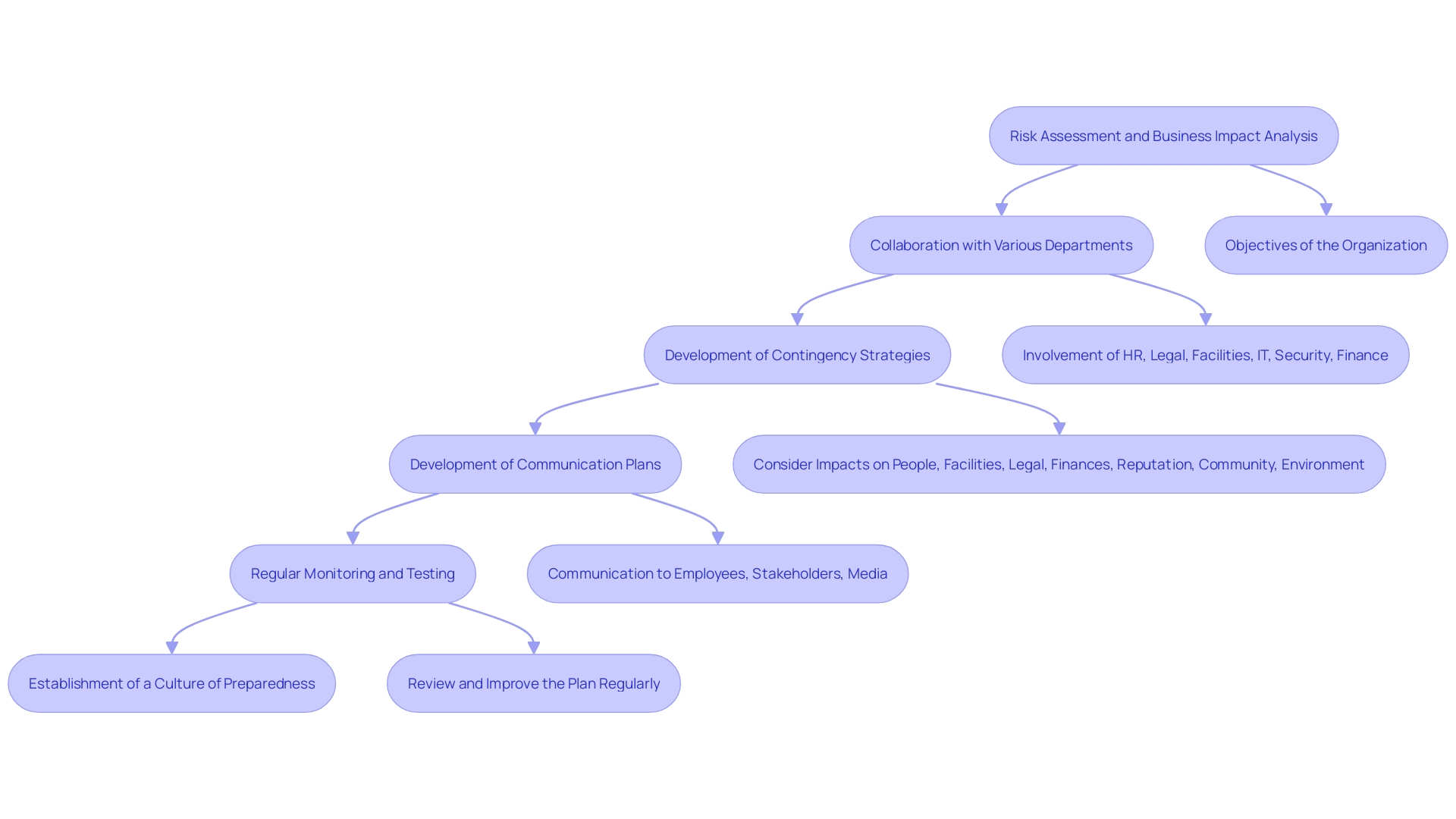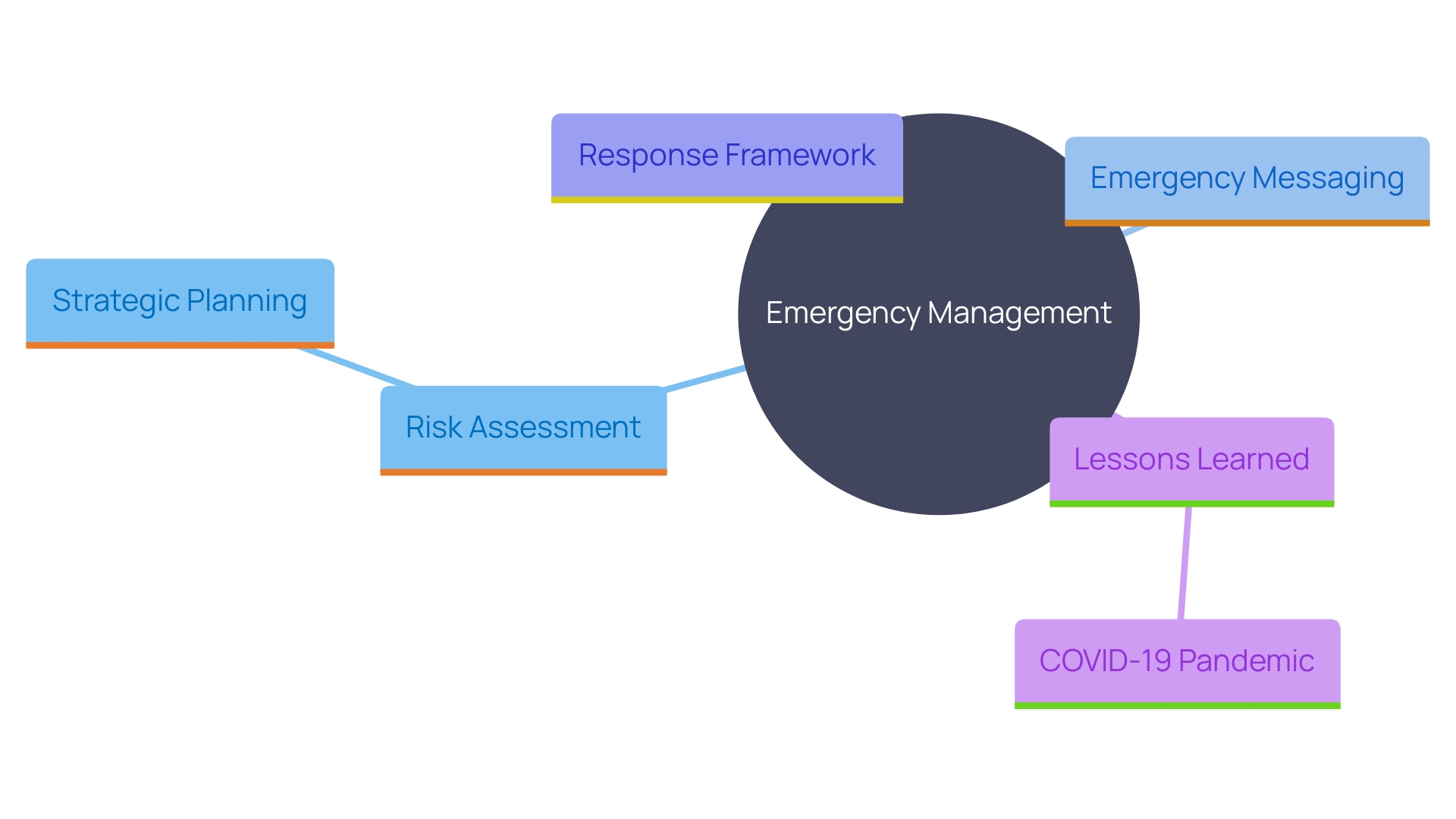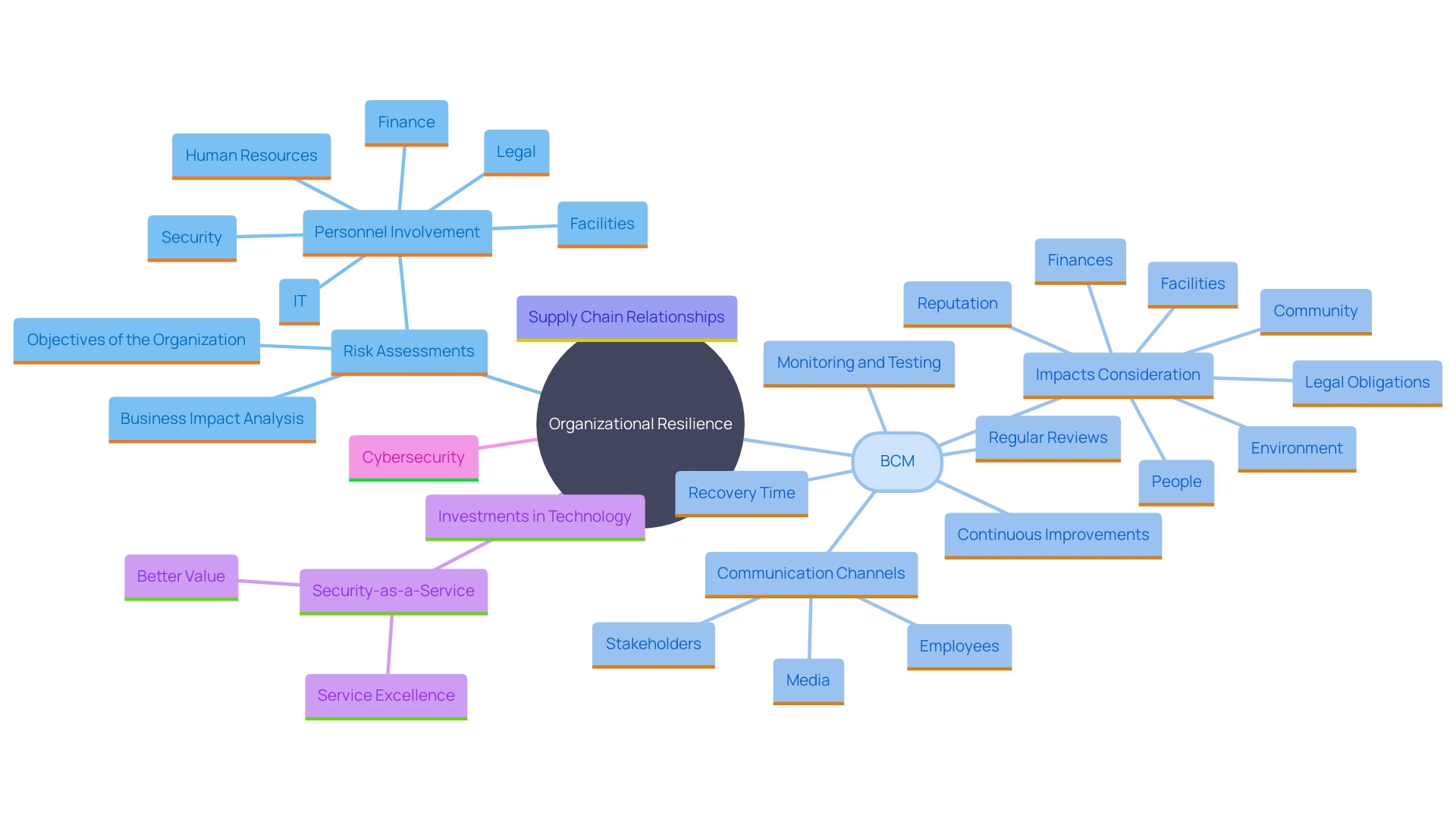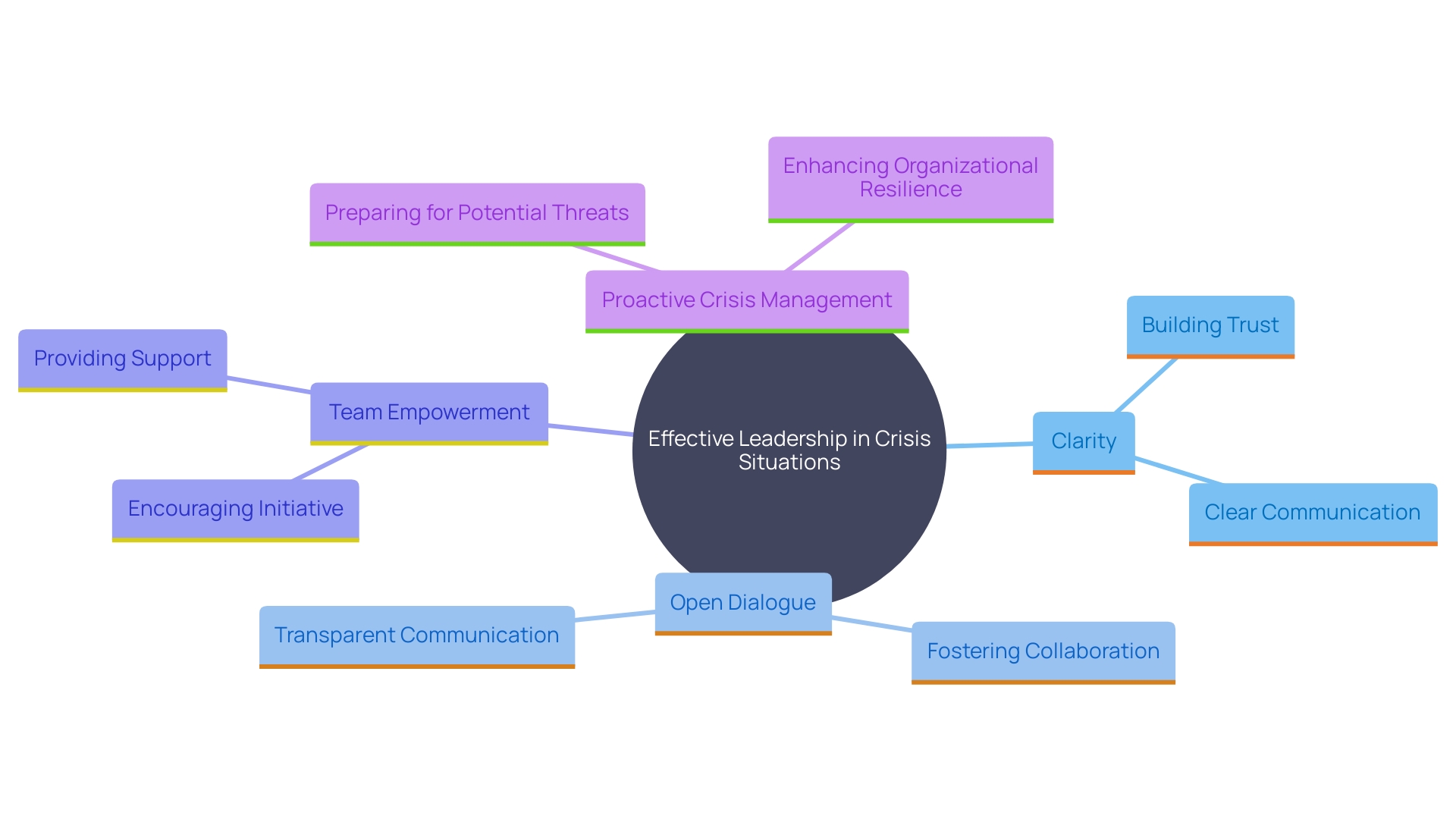Introduction
In a world where uncertainties and disruptions are inevitable, effective crisis management is paramount for organizational resilience. This article delves into the essential strategies and components that businesses must adopt to navigate crises successfully. From proactive planning and comprehensive risk assessments to robust communication frameworks and leadership acumen, each section provides actionable insights for Chief Financial Officers (CFOs) and other leaders.
By integrating these elements into their operational fabric, organizations can enhance their preparedness, ensure swift recovery, and maintain stability in the face of adversity. Discover how to build a resilient enterprise that not only withstands crises but thrives through them.
The Importance of Proactive Planning
Proactive planning is the cornerstone of effective organizational crisis management. The process begins with a comprehensive risk assessment and a detailed business impact analysis, aligned with organizational objectives. This involves the collective effort of personnel across various departments such as human resources, legal, facilities, IT, security, and finance. By evaluating current processes and identifying vulnerabilities, organizations can develop robust contingency strategies that address impacts on people, facilities, legal obligations, finances, reputation, community, and the environment.
A critical component of this planning is determining the maximum allowable time to recover from an incident and establishing clear communication channels for employees, stakeholders, and the media. Regular monitoring, testing, and updates are essential to ensure the strategy remains effective. For instance, during natural disasters, having a well-prepared and tested continuity management (BCM) plan can significantly enhance an organization's resilience and agility.
By embedding a culture of preparedness and continuous improvement, businesses can not only mitigate risks but also ensure swift recovery and sustained operations during emergencies. This strategic approach is vital for navigating the complexities and uncertainties that modern organizations face.

Key Components of Effective Crisis Management
Efficient emergency management necessitates a multifaceted approach. At its core, it involves a thorough risk assessment to identify potential threats and vulnerabilities. This is essential for developing a strategic plan that can address various emergency scenarios, from natural disasters to cyberattacks. The significance of emergency messaging tactics cannot be exaggerated. During periods of emergency, transparent and prompt exchange of information is essential. As emphasized by the HSMAI Global Distribution Advisory Board, leaders must ensure they have processes in place to relay information promptly, even when traditional messaging channels are compromised.
A robust response framework is another critical component. This involves having predefined protocols and a well-trained response team ready to act immediately. For instance, IBL, operating in more than 23 nations and hiring over 26,000 staff members, has effectively managed numerous challenges by utilizing its pioneering spirit and innovative strategies. Their approach underscores the importance of having a balanced innovation portfolio focused on all categories of innovation, not just sustaining and efficiency ideas.
Coordinated planning and transparent communication channels are essential for sustaining operational stability during emergencies. Leaders can draw lessons from the COVID-19 pandemic, which fundamentally transformed the business landscape and highlighted the need for adaptable and resilient management strategies in challenging situations. As difficult situations present both challenges and opportunities, they offer a chance to develop leadership and strengthen organizational resilience. By learning from past experiences and continuously refining their strategies, organizations can better prepare for future crises and ensure long-term stability.

Strategies for Building Business Resilience
Creating organizational resilience necessitates a multifaceted strategy that incorporates risk management, continuity planning, and technological advancements. To start, organizations should conduct thorough risk assessments and business impact analysis. This process should involve personnel from various departments, including human resources, legal, IT, and finance, to ensure a comprehensive understanding of potential risks and their impacts. A well-rounded Business Continuity Management (BCM) strategy should address these impacts on people, facilities, legal obligations, finances, reputation, the community, and the environment.
Furthermore, the BCM strategy should outline the maximum allowable time for recovery and establish clear communication channels for employees, stakeholders, and the media. Continuous monitoring, regular testing, and iterative improvements are crucial to maintaining an effective BCM plan. Organizations should also focus on reinforcing relationships with suppliers and vendors to ensure a resilient supply chain, particularly in light of recent disruptions such as natural disasters and economic challenges.
In 2023, organizations nearly doubled their investments in supply chain innovation, driven by factors like labor shortages and rising shipping costs. This trend underscores the importance of supply chain digitalization to enhance adaptability and responsiveness. Investing in cybersecurity measures is also essential to safeguard against digital threats that could worsen situations. By adopting a proactive and integrated approach, organizations can build resilience and ensure continuity in the face of diverse challenges.

Leadership in Crisis Management
Effective leadership is indispensable during a challenging situation. Leaders must remain composed and decisive, projecting confidence to their teams. 'Clarity and open dialogue are vital in building trust and fostering collaboration.'. By empowering teams and encouraging feedback, leaders can create a unified approach that is better equipped to manage challenges. Effective guidance not only steers through the current challenge but also establishes the groundwork for enduring strength.
Public relations emergency management, for instance, seeks to reduce the harm a negative occurrence inflicts on an organization, its stakeholders, and its brand image through effective communication. Whether it's a cyber attack leading to a data breach or a health and safety issue, the role of leadership is to manage the fallout and restore trust. Leaders must identify strengths and weaknesses, recognize skill gaps, and develop targeted initiatives to build a resilient team.
Data shows that 79% of business leaders expect generative AI to lead to a catastrophic cyberattack within the next year, underscoring the importance of preparedness and strong leadership. Leaders must not only respond to crises but also anticipate and plan for potential threats, ensuring their teams are equipped to handle any situation.

Conclusion
Proactive planning serves as the foundation of effective crisis management, enabling organizations to navigate uncertainties with confidence. By conducting comprehensive risk assessments and business impact analyses, businesses can identify vulnerabilities and craft contingency plans that address a wide array of potential impacts. This strategic approach emphasizes the importance of embedding a culture of preparedness, ensuring that organizations are not only reactive but also resilient in the face of adversity.
Key components of effective crisis management include robust communication strategies and a well-trained response framework. Clear and timely communication is essential during crises, allowing leaders to relay critical information even when traditional channels are compromised. Organizations that integrate these practices into their operational frameworks can maintain stability and adapt to challenges, drawing lessons from past experiences to refine their strategies continuously.
Building business resilience requires a multifaceted approach that encompasses risk management, business continuity planning, and technological advancements. By investing in supply chain innovation and cybersecurity measures, organizations can enhance their adaptability and responsiveness to disruptions. This proactive mindset not only prepares businesses for immediate challenges but also positions them for sustained success in the long term.
Leadership plays a pivotal role in crisis management, with effective leaders fostering a culture of transparency and collaboration. By empowering teams and facilitating open communication, leaders can navigate crises while also laying the groundwork for future resilience. As the business landscape continues to evolve, the ability to anticipate and prepare for potential threats will be crucial for maintaining operational stability and trust among stakeholders.




